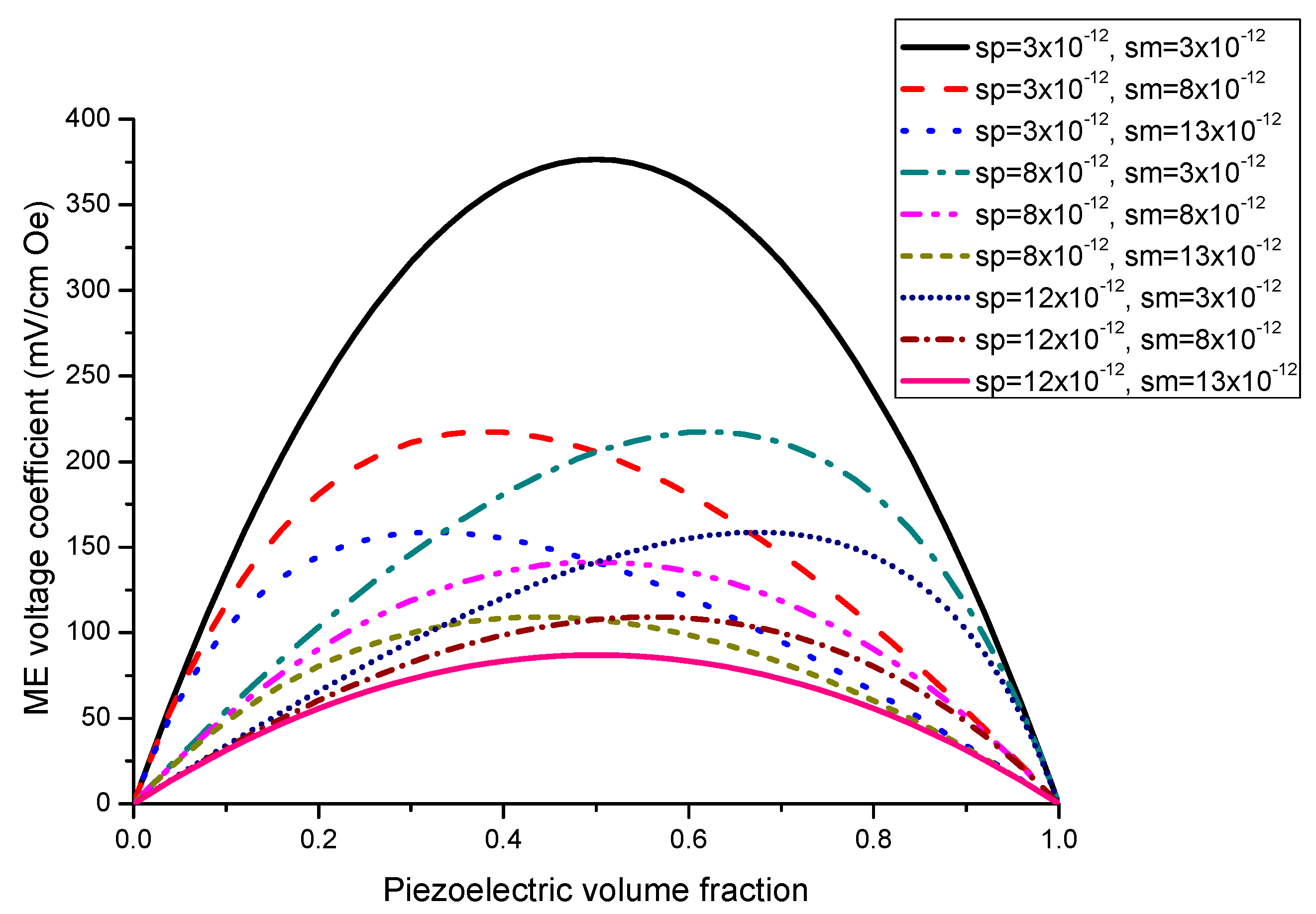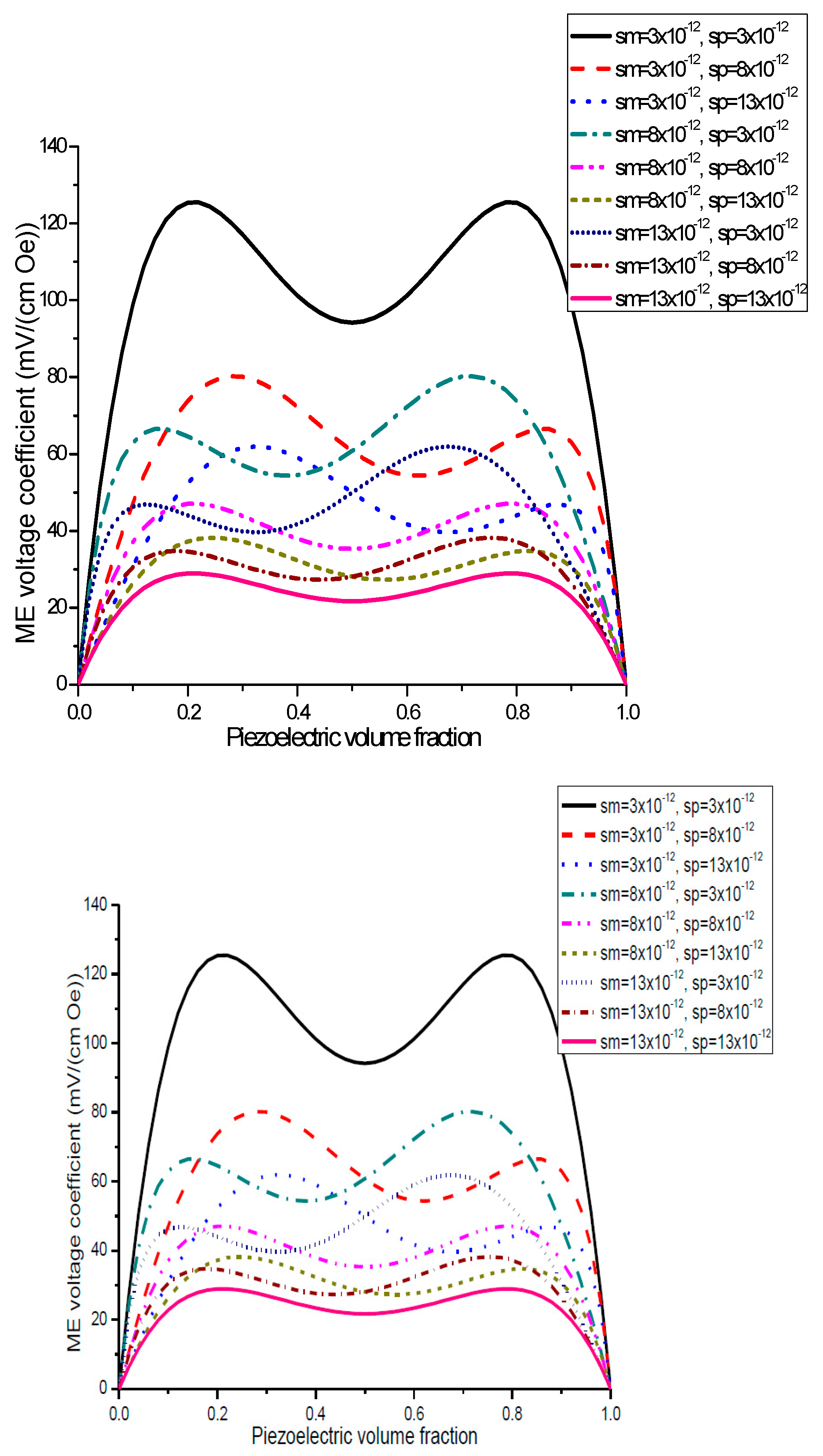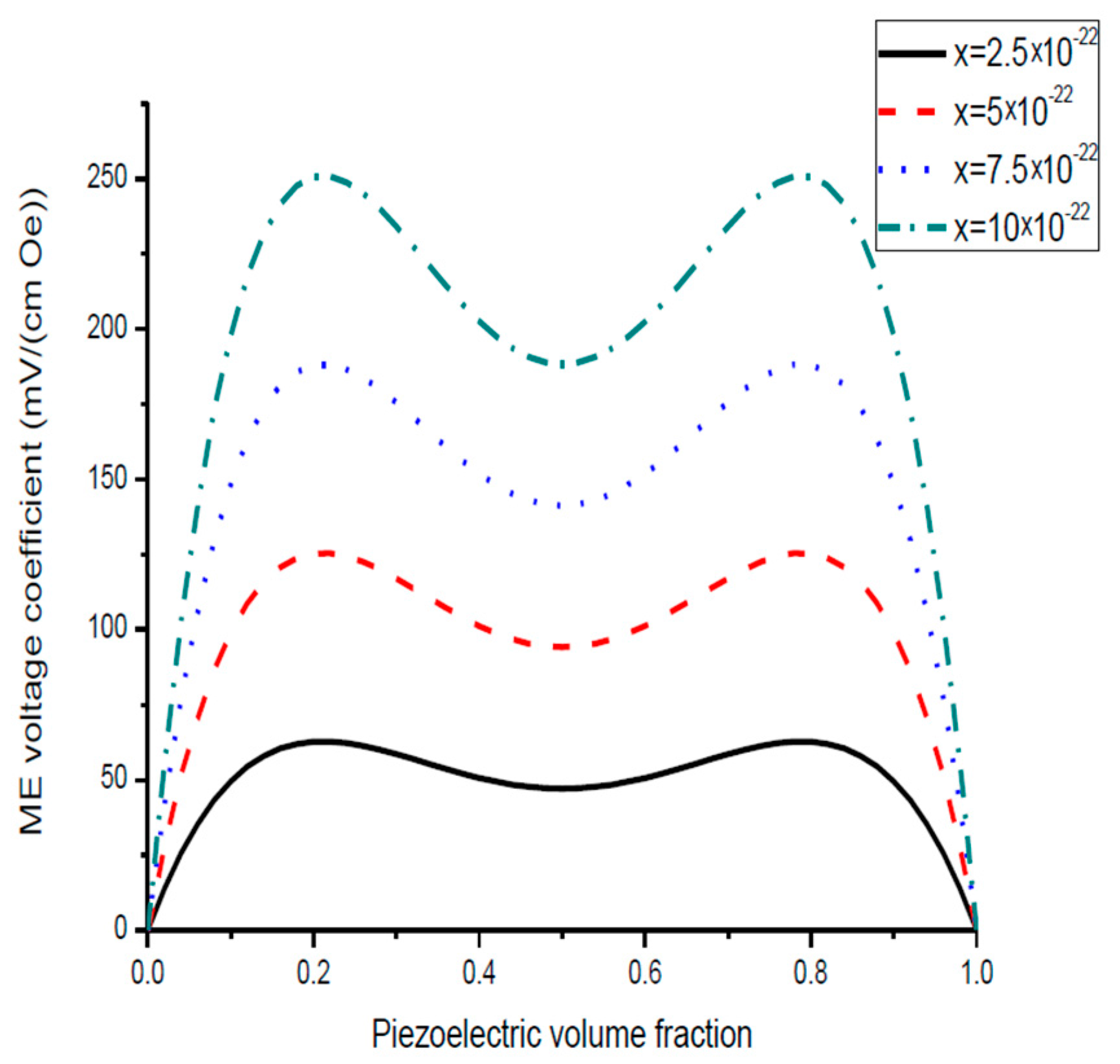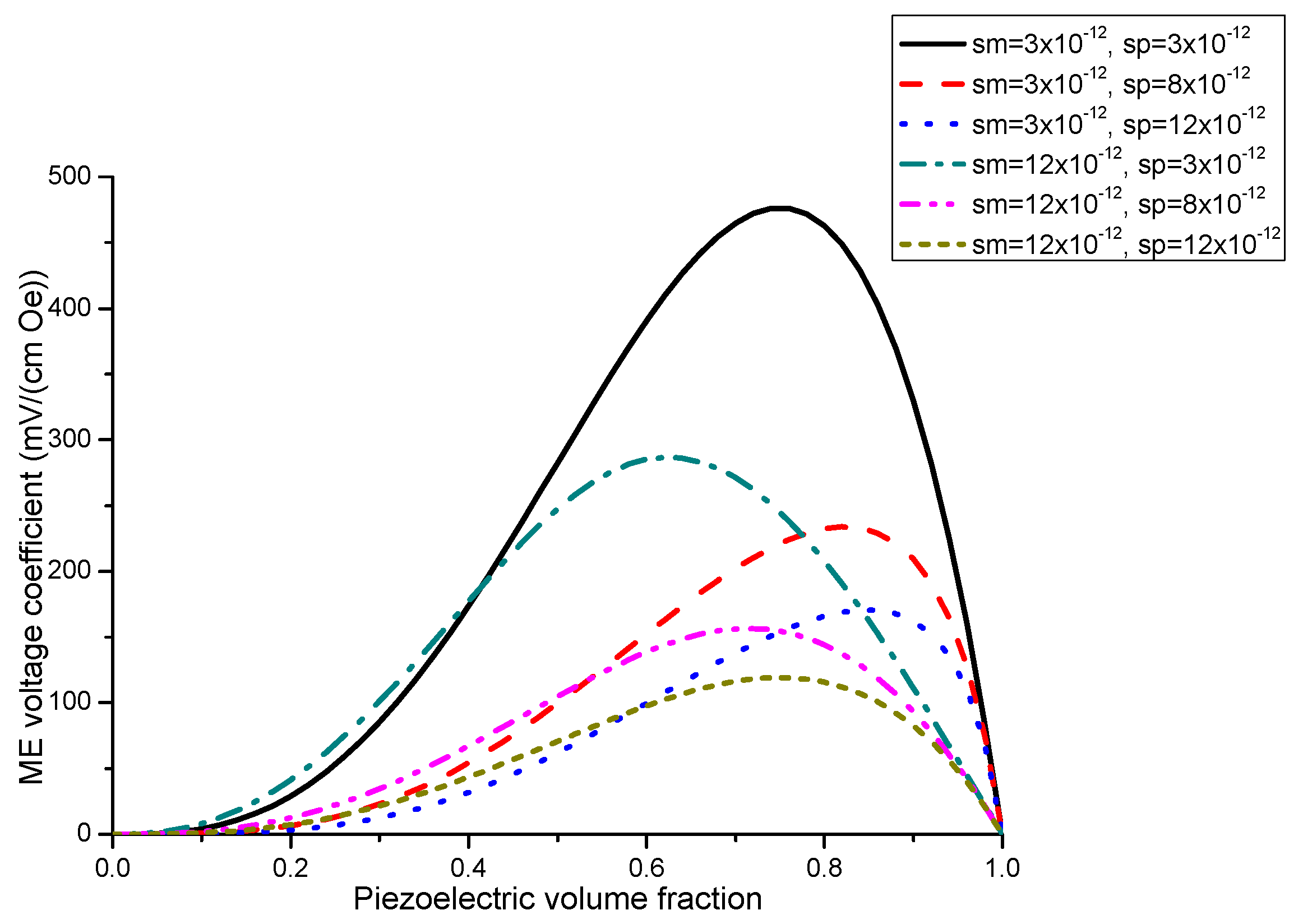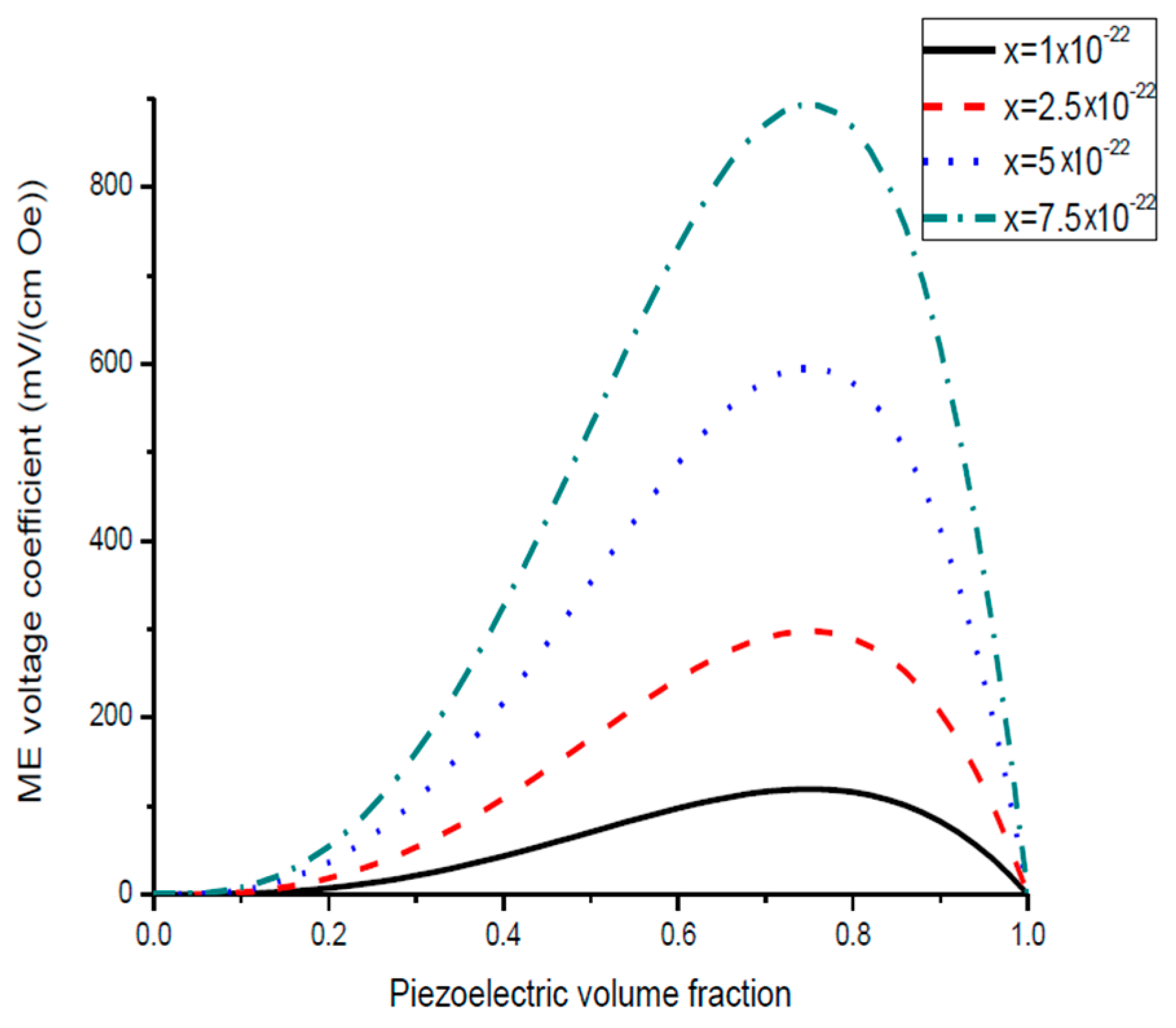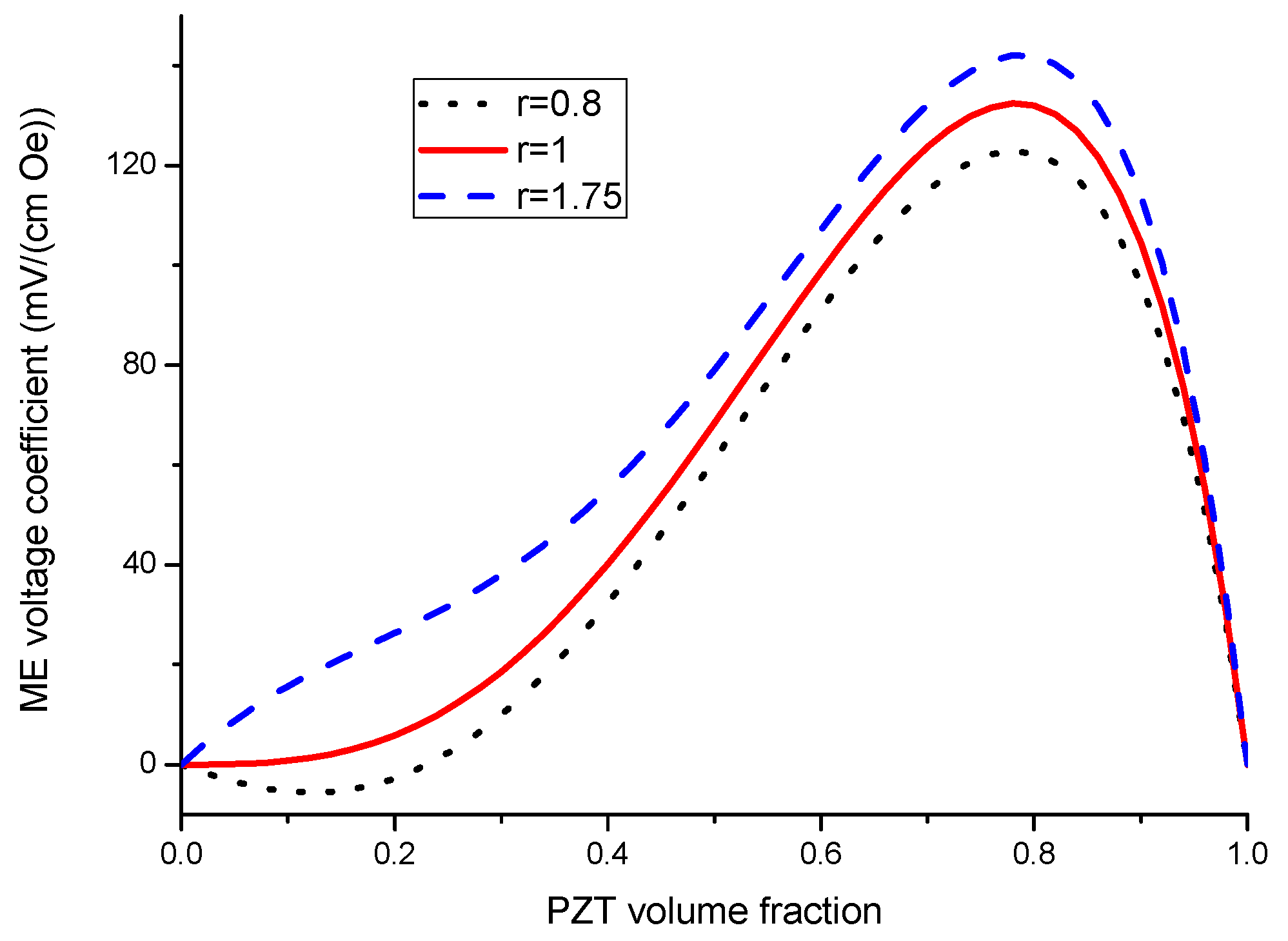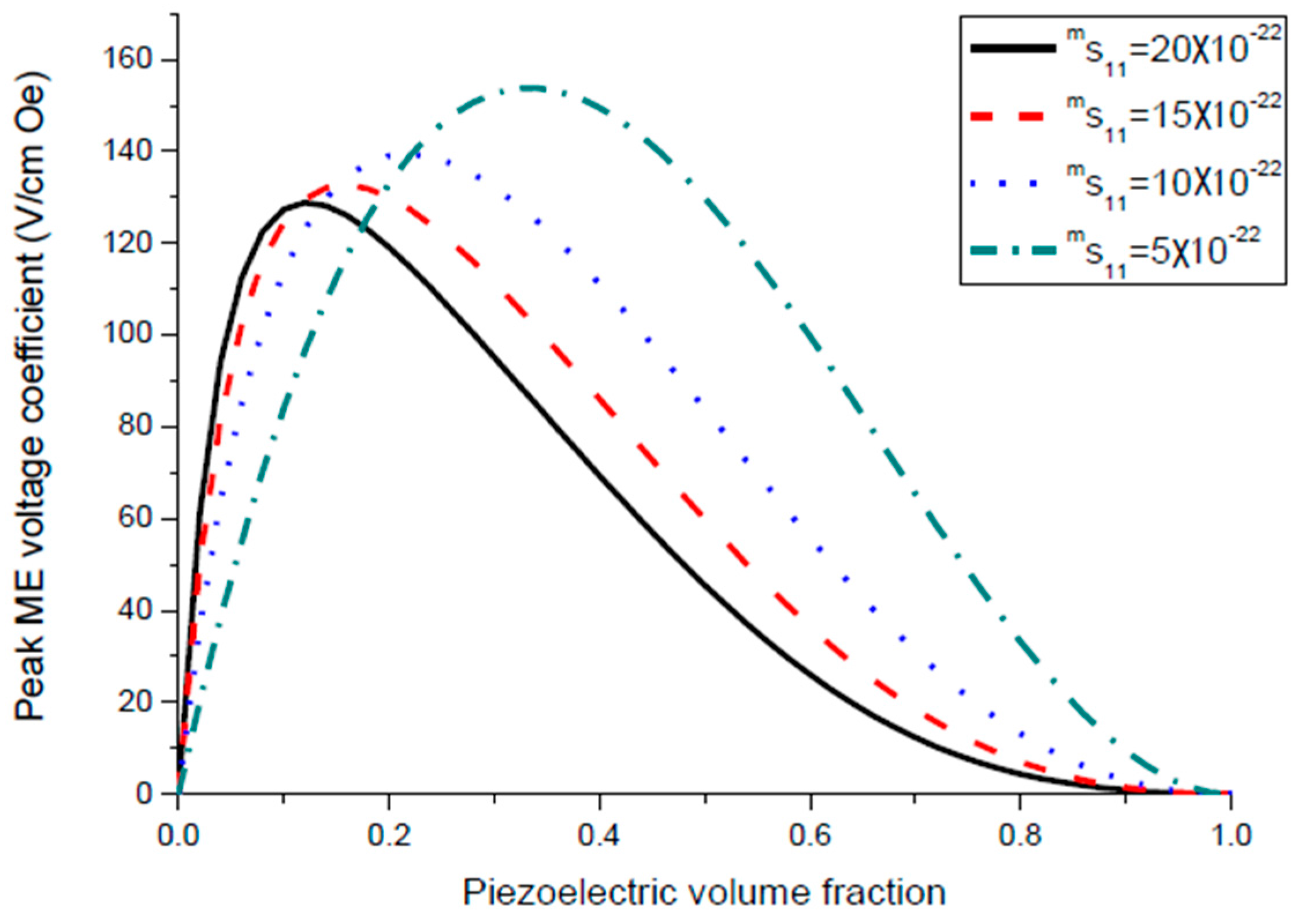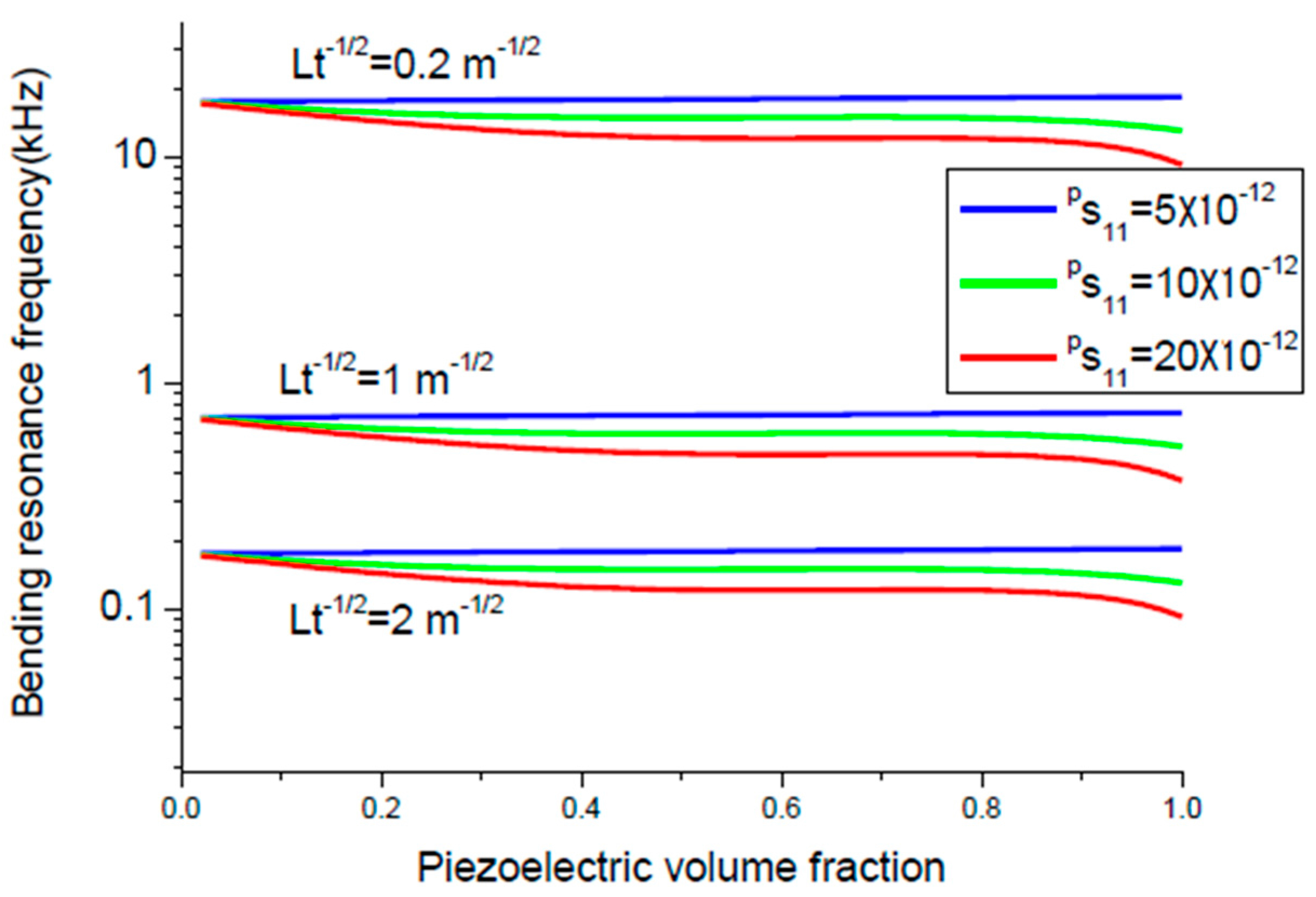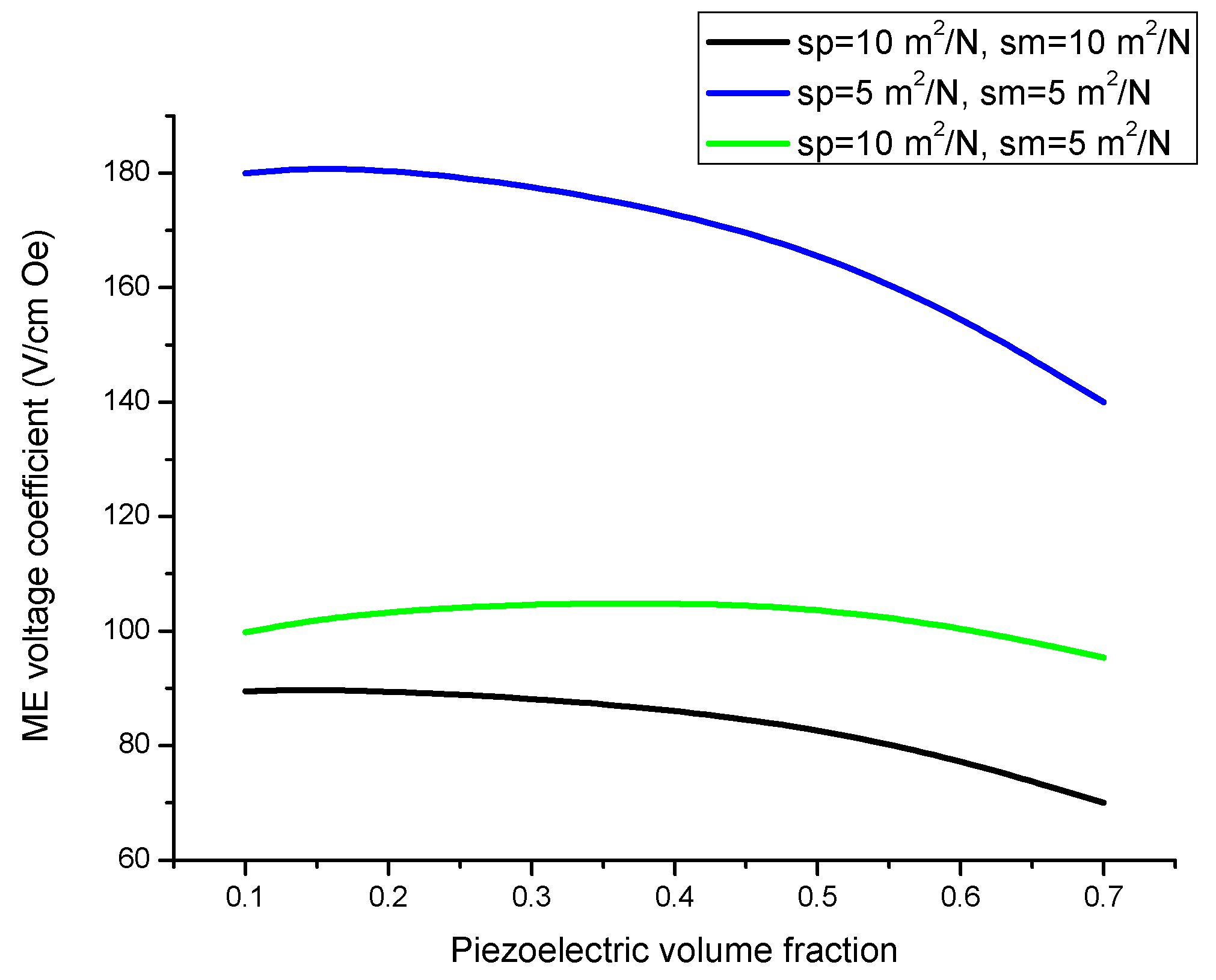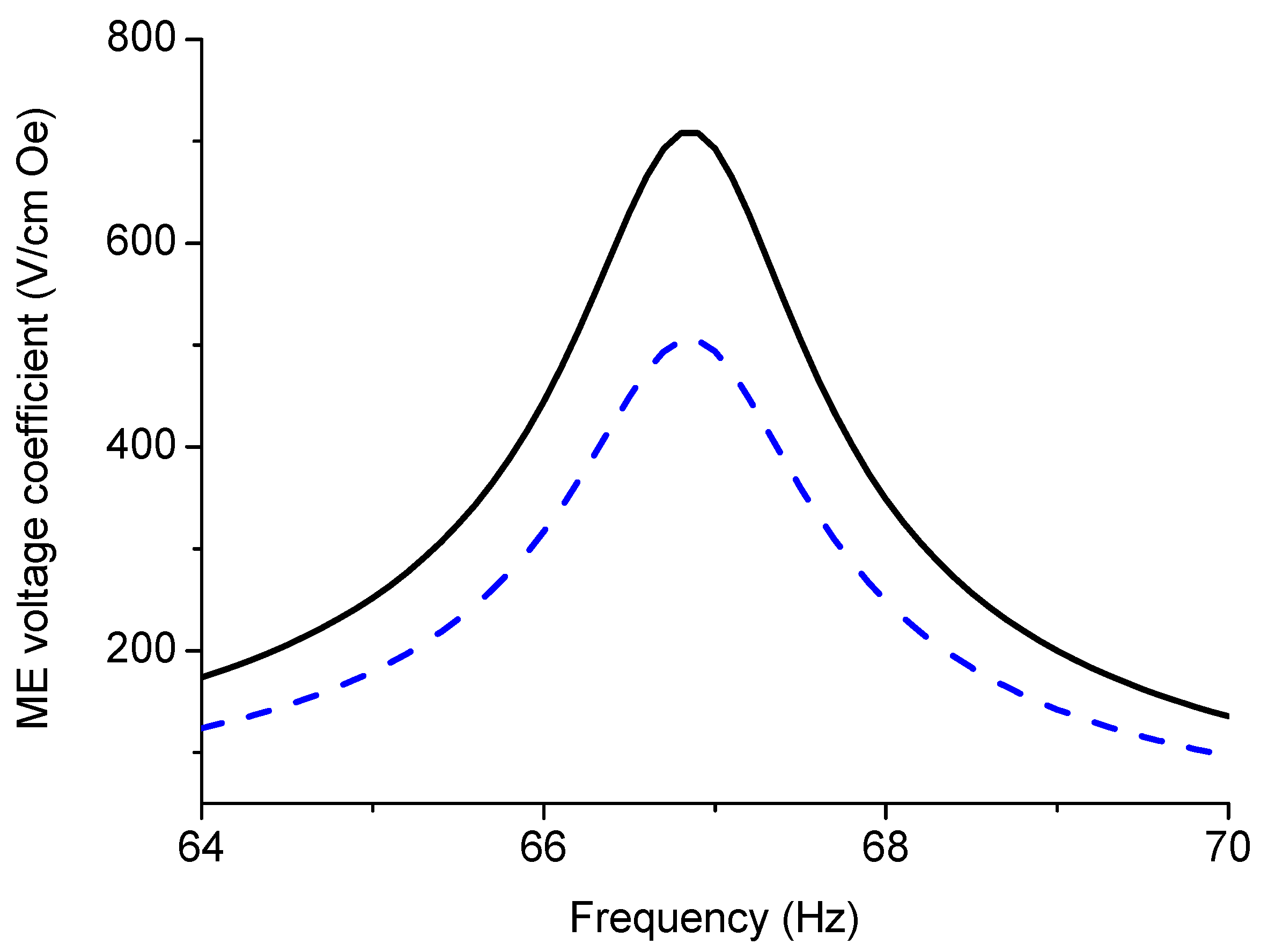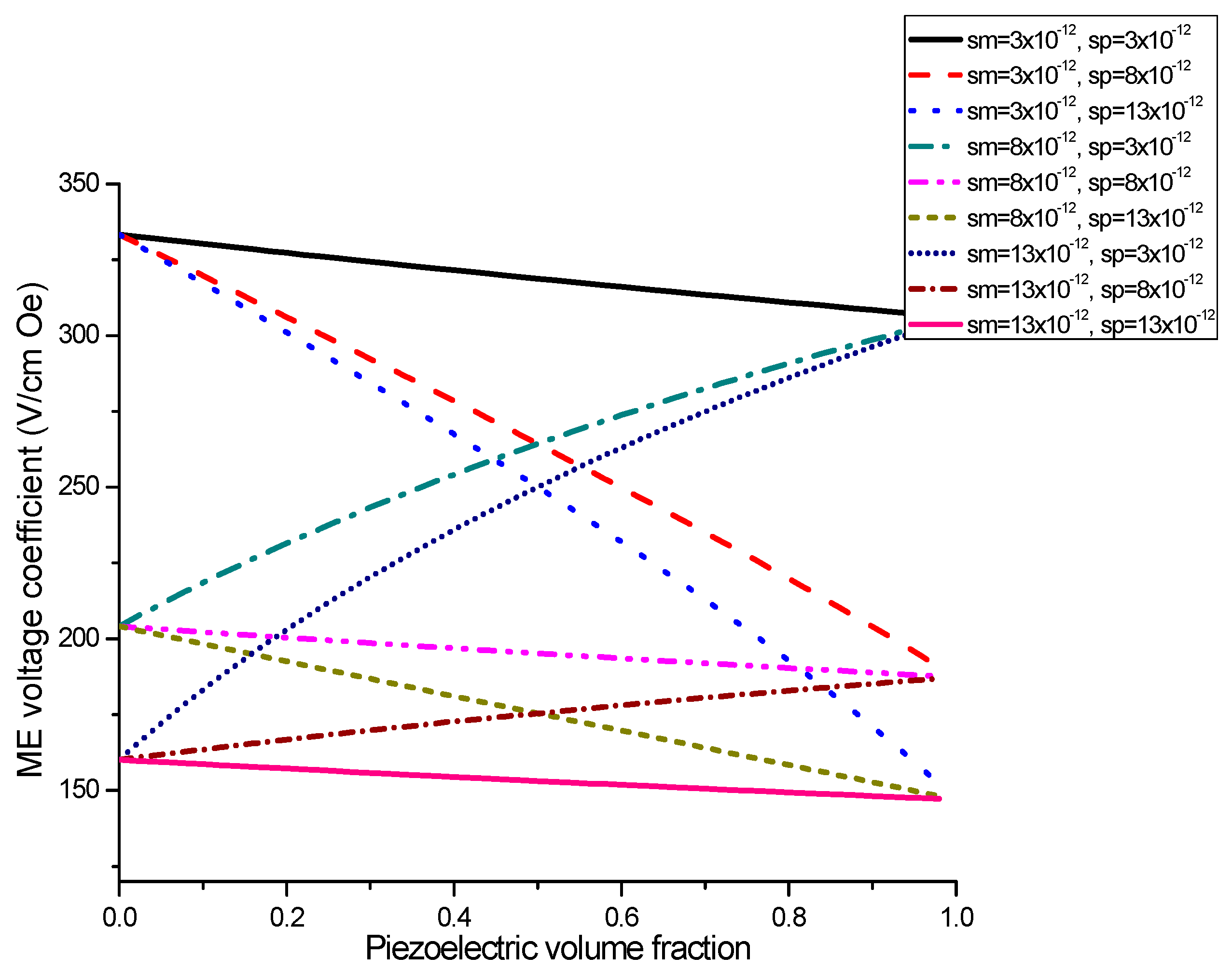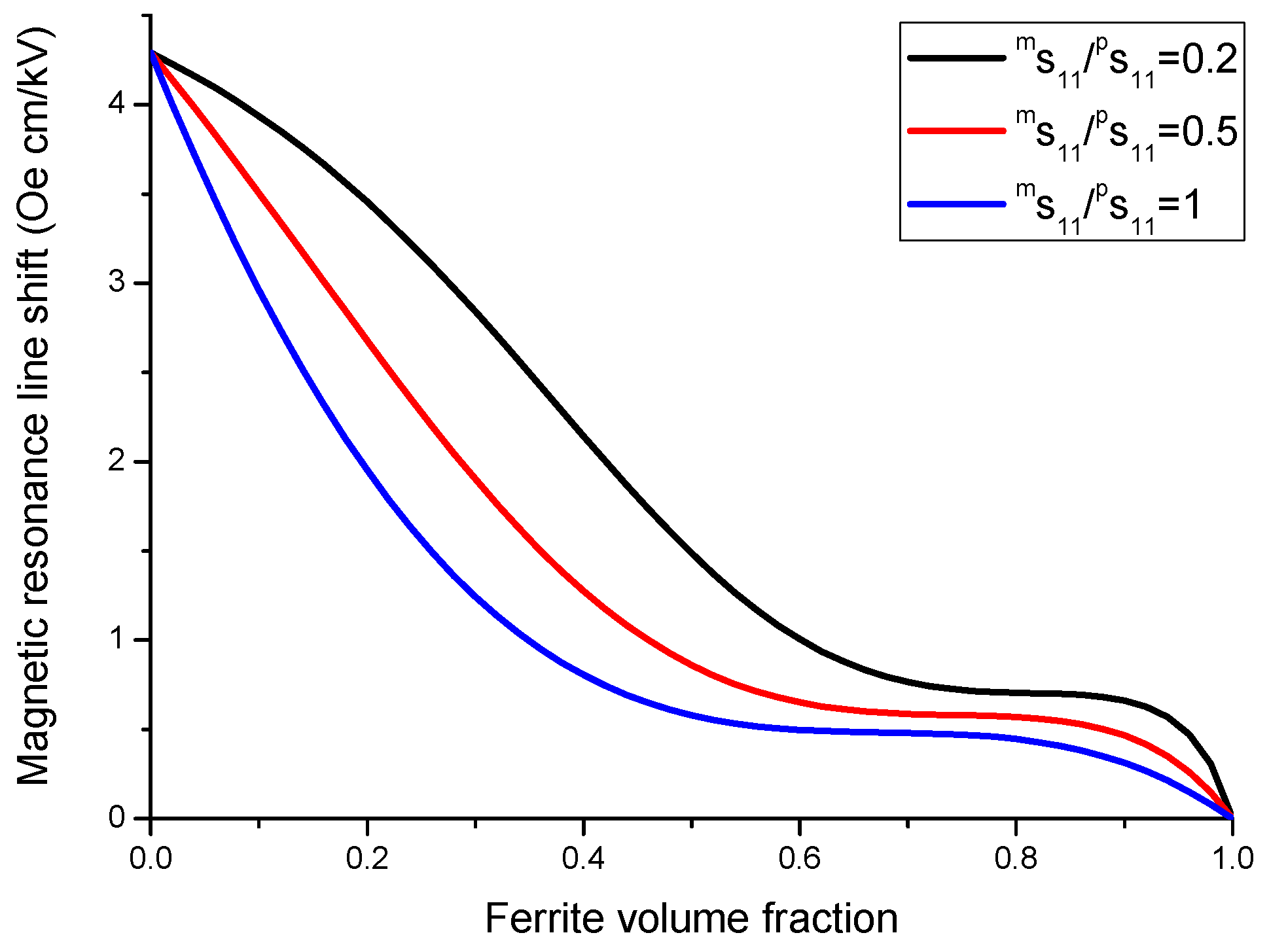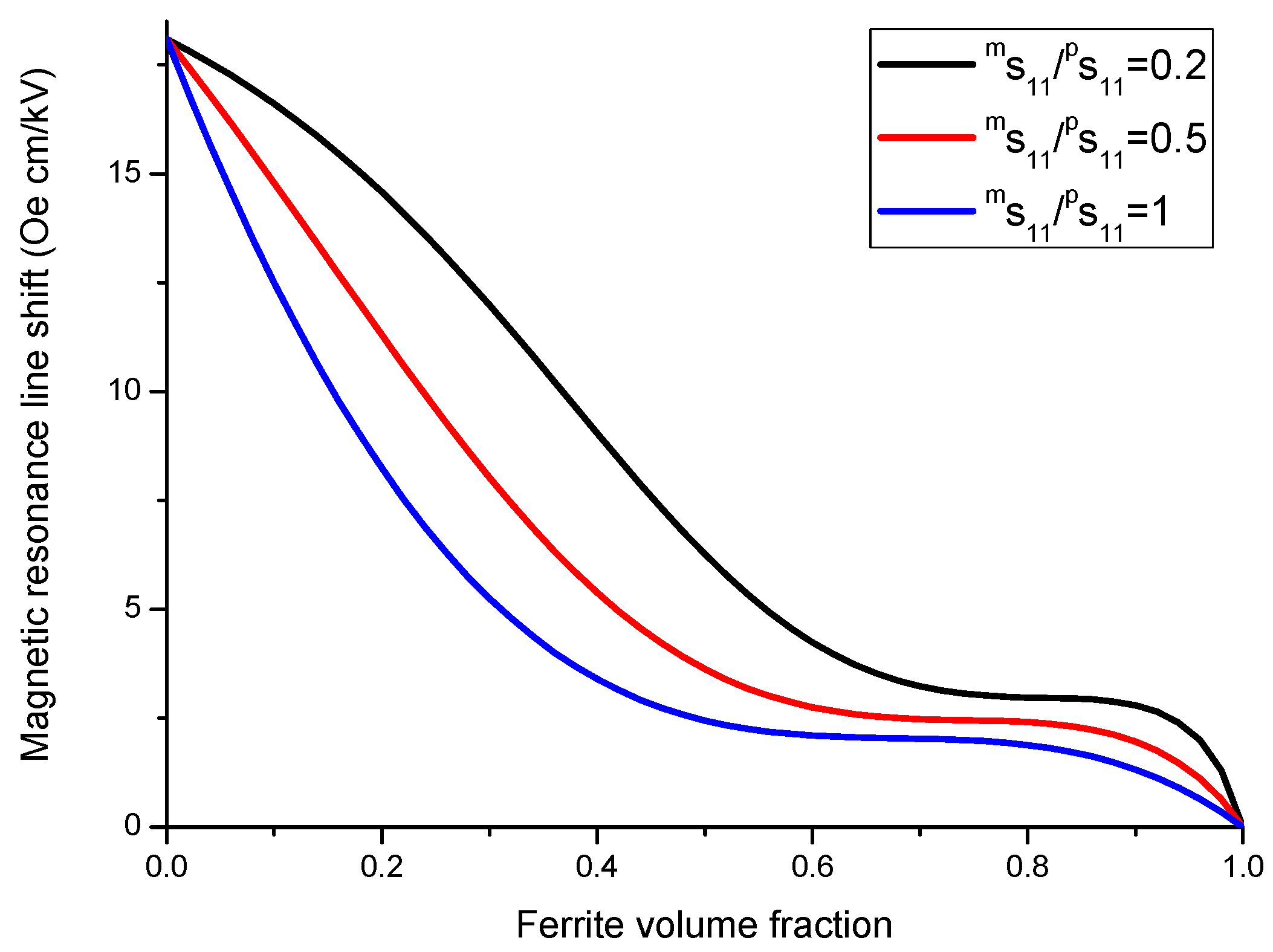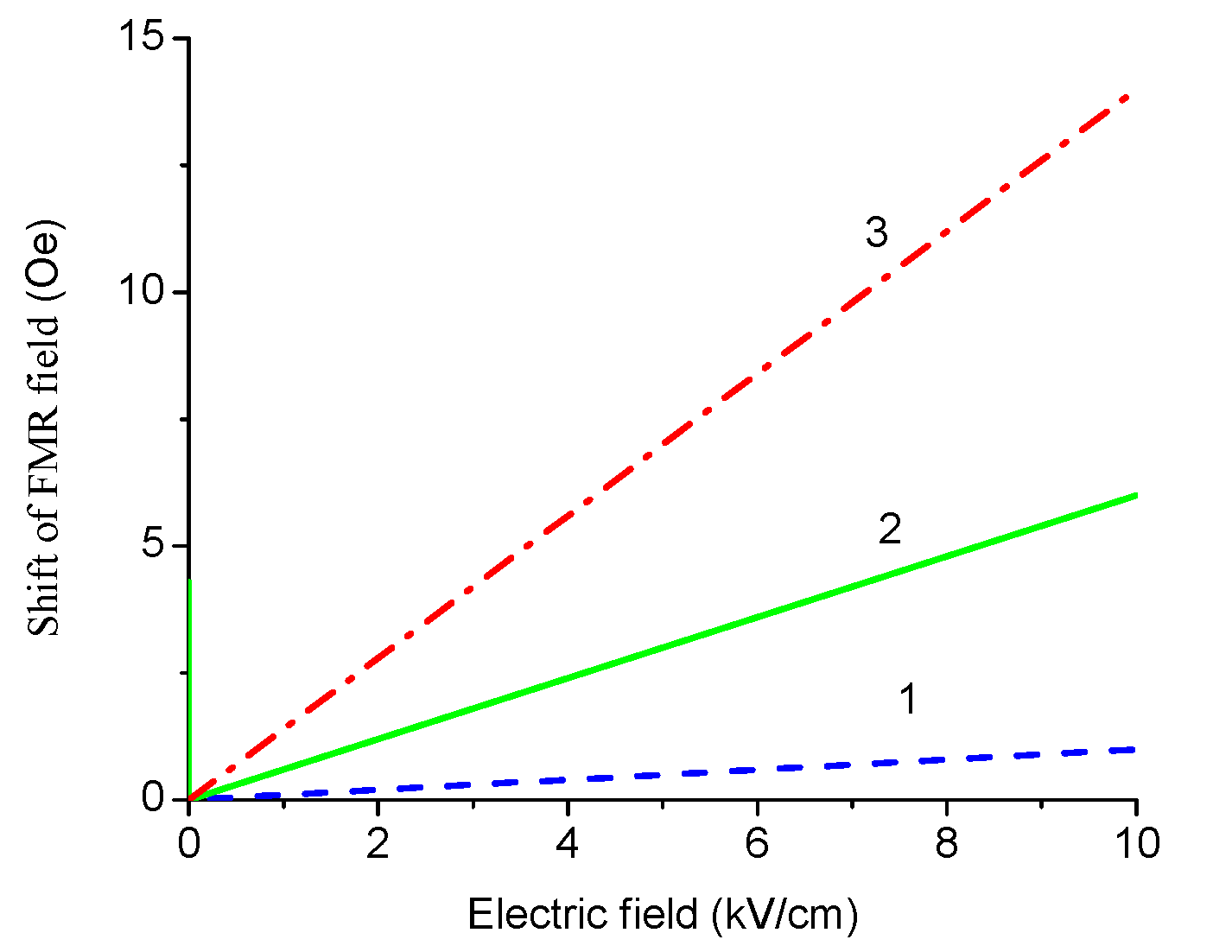1. Introduction
Magnetoelectric (ME) interaction in magnetostrictive-piezoelectric multiferroic structures consists in inducing the electric (magnetic) field in an applied magnetic (electric) field and is a product property of magnetostriction and piezoelectricity in components. The coupling between the magnetostrictive and piezoelectric subsystems is implemented by mechanical strains. The electric to external magnetic field ratio referred to as ME voltage coefficient is the key parameter of ME coupling strength. Ferromagnetic-ferroelectric composites are under intense study in recent years for potential use in sensors, energy harvesters, and for signal processing. Composites of magnetostrictive metals, alloys, or oxides and piezoelectric lead zirconate titanate (PZT), barium titanate, lead magnesium niobate-lead titanate (PMN-PT), or quartz-like crystals demonstrated a giant ME effect in the low frequency and electromechanical resonance (EMR) regions [
1,
2,
3,
4,
5,
6,
7,
8,
9,
10,
11,
12,
13,
14,
15,
16,
17]. Using nomographs for a quick test of ME composites for applications where a rapid estimate is relevant and useful was reported recently.
The induced polarization P is expressed in terms of applied magnetic field
H by the expression, P = αH, with α being the ME susceptibility. ME effect in Cr
2O
3 was first investigated. The strongest ME coupling obtained for a single crystal Cr
2O
3 [
1] is α = 20 mV/(cm·Oe). Strong ME coupling in magnetostrictive-piezoelectric composites was recently observed due to appropriate choice of material properties and proper sample design. The most investigated composites are Ni-Co ferrite/PZT, Terfenol-D/PZT and Metglas/PZT. The highest ME voltage coefficient of 500 V/cm·Oe was found for an amorphous magnetostrictive alloy/piezofiber layered structure [
3]. These studies enabled making ME structures with high ME coefficients in a wide frequency region and practical application possibility [
4,
5,
18].
A theoretical model of the anisotropic ME effect as a function of the crystallographic orientation in trilayers of Metglas and piezoelectric single crystals was discussed recently [
19,
20]. The peak value of direct transversal ME voltage coefficients was estimated. The magnetoelectric coupling can be increased (up to 500 V/cm·Oe) by using the appropriate cut angle of LiNbO
3, thickness of the LiNbO
3 and Metglas layers, and a better bonding between ferromagnetic and ferroelectric layers [
21]. Multiferroic bulk composites and nanocomposites were considered in respect to theoretical phenomenological and first-principles estimates of ME effect and their applications [
22].
Piezoelectric component of a layered structure must be polarized to reveal high piezoelectric coupling coefficient and strong ME coupling. The poling procedure includes heating the sample to 450 K, and cooling to room temperature in applied dc electric field of E = 20–50 kV/cm. A laminate under study is placed into the bias magnetic field up to 18 kOe produced by an electromagnet. Helmholtz coils generate ac magnetic field
δH applied to the magnetostrictive layer parallel to bias field
H. The ac voltage
δV measured across the piezoelectric layer is used for calculating the induced electric field
δE. The ME coefficient
αE is estimated for three orientations of magnetic and electric fields: (1)
αE,31 is measured for transverse fields’ orientation which involves
H and
δH parallel to the sample plane and
δE perpendicular to the sample plane, (2)
αE,33 is estimated for longitudinal fields’ orientation with all the three fields perpendicular to sample plane, and (3)
αE,11 is defined as ME voltage coefficient for in-plane fields’ orientation with in-plane poling direction, electric and magnetic fields. When the laminate undergoes electromechanical resonance (EMR), a significant increase in ME coupling strength is obtained [
23,
24,
25]. This phenomenon is of vital importance for practical application. A summary of the most recent advances in the physics and applications of the magnetoelectric effect in composite multiferroics was recently published [
26].
Other phenomenon of technological importance is ME effect at FMR. A dc electric field generates a strain of the piezoelectric phase which is transferred to magnetic phase. Stressed magnetic layer shows a shift in the FMR frequency. In what follows we estimate ME effects in the wide frequency range.
Because the ME coupling in magnetostrictive-piezoelectric composites is a result of mechanical strains, the key parameters that determine the ME coupling strength are the piezoelectric coefficient
d and the piezomagnetic coefficient
q. The ME coupling strength can be increased by grading these parameters. For example, using the layered structure with graded piezoelectric or/and piezomagnetic layer in out-of-plane direction gives rise to an additional bending moment. The bending moments are known to influence the ME effect strength. Theoretical models that considered ME coupling in the low-frequency and EMR regions in bilayers with out-of-plane grading of
d and
q were described recently. Estimates of ME voltage coefficient showed that the ME interaction in graded structures is 50–60% stronger compared to homogeneous systems [
14,
15]. In addition, it was shown that internal magnetic and electric fields in graded materials enable one to simplify the ME material based devices design since it is possible to exclude elements creating external bias field, and simplify the technological process of material production since it is possible to exclude preliminary polarization of material sample [
16].
This work deals with ME interactions in layered magnetostrictive-piezoelectric composites based on homogeneous and functionally graded components. In an asymmetric ferromagnetic-piezoelectric bilayer, an ac magnetic field produces axial and flexural strains simultaneously [
11,
17]. The asymmetry related flexural deformation can be produced in functionally stepped ferromagnetic or/and piezoelectric layer [
15,
18].
5. Magnetoelectric Coupling in FMR Region
Here we discuss the ME interactions in microwave region in two-layer structures based on piezoelectric and single crystal ferrite with graded anisotropy induced by dc electric field. The ferrite plate is bonded to piezoelectric layer. Electric field applied to piezoelectric layer gives rise to flexural deformations due to the asymmetry of structure. Thickness-dependent strains are transmitted to the ferrite phase and induce the magnetic anisotropy which varies across the thickness [
11]. Apart from the fact that the low line width facilitates the precise measurements of ME effect, the model described here provides evidence for electric control of magnetic resonance line width. As opposed to the prediction of variation in ferromagnetic resonance absorption due to the applied electric field to graded ferroelectric, we suggest using the ferrite/piezoelectric bilayer with homogeneous piezoelectric layer. In this case, the applied electric field gives rise to flexural deformations that result in the thickness-dependent induced anisotropy and thus in the shift and broadening of FMR line. This can be useful for microwave applications. Magnetic susceptibility with regards to ME coupling was estimated in terms of component material parameters.
To estimate the magnetic anisotropy induced by applied electric field, we discuss a ferrite/piezoelectric bilayer. Ferrite is assumed to be in a state of saturation due to out-of-plane dc magnetic field. To find the magnetic susceptibility, we solve the Landau-Lifshitz equation of motion for magnetization which is nonlinear in the main case. However, the equation can be linearized provided that ac components of magnetic field and magnetization are small compared to dc components. In that case, solution can be easily found by using the effective demagnetization factor method. The magnetic susceptibility is known to be expressed as:
Where
where γ, ω, and
are the magneto-mechanical ratio, angular frequency, and demagnetization coefficients corresponding to all types of magnetic anisotropy with
denoting a frame of axis with
-axis directed parallel to the equilibrium magnetization. Equation (13) comprises magnetic form anisotropy, magnetic crystallographic anisotropy, and electric field induced magnetic anisotropy. Demagnetization coefficients arising from the magnetic crystalline anisotropy
Naik and magnetic anisotropy
NEik induced by dc electric field are specified by following equations:
In Equation (14), b1111 = b2222 = b3333 = 3λ100/(2M02), b1212 = b1313 = b2323 = 3λ111/M02, λ100 and λ111 are magnetostriction coefficients, and mTij is the electric field induced stress component. β is direction cosine matrix corresponding to axes (1,2,3) with respect to the axes (1′,2′,3′).
Solving the linearized equation of motion for magnetization with dissipative term
iωa (M0 × m)/M0 (
a is the dissipation parameter) enables one to get the expressions for the magnetic susceptibility component
χ1 =
χ’ +
i χ″ in the form:
To find the electric field induced stress, we employ the elasticity equation for piezoelectric layer:
where
pE3 is the internal electrical field;
pS1,
pd31, and
ps11 are the deformation, piezoelectric constant, and elastic flexibility of the piezoelectric layer, correspondingly.
As an example, we suppose that the piezoelectric layer is polarized along the [111] axis of ferrite phase. Elasticity equation for ferrite layer is as follows:
Here mTi and mSk, are the stress and deformation components of the ferrite, correspondingly.
The layers are assumed rigidly connected and the ferrite layer prevents piezoelectric layer’s free contraction when dc external electric field is applied. The forces produce bending moments on each layer due to asymmetry of the structure. To take account of the flexure, the axial deformations of layers have to be dependent on coordinate
zi [
14]:
where
mS10 and
pS10 are the deformations along
x axis corresponding to layer’s middle plane and
R1 is the bend radius,
zm and
zp are counted off from the middle plane of layers.
From geometric consideration, one can see that mS10 − pS10 = hm/R where hm = (mt + pt)/2 with mt and pt being the thicknesses of ferrite and piezoelectric phases.
For the sample in equilibrium state, the resultant force and moments should vanish:
where
and
are the transverse force and bending moment per unit width.
For solving Equation (19) for mS10 and R, the stress components should be expressed from Equations (16) and (17). Substituting the centroidal strains and radius of curvature into the Equation (19) enables finding the axial stress mT1. Note that mT1 depends on z due to flexural deformations. Taking into account Equations (17) and (18) and found mT1, Equation (19) results in magnetic susceptibility components that vary with z.
Bending the sample have two implications: (i) it reduces the stress of ferrite layer and thus ME effect, (ii) the actual manuscript provides evidence that flexural deformations lead to the electric field induced broadening of FMR line. The FMR line broadening can be estimated as the difference between two peaks in magnetic field dependence of χ″.
We assume magnetic anisotropy induced by dc electric field small compared to other types of anisotropy. The FMR line shift can be expressed for this case in the linear approximation [
13]:
where:
As an example, we apply our model to a specific direction of bias field
H parallel [111] axis. Variation of the shift of FMR field with volume fraction of ferrite phase is given in
Figure 16 and
Figure 17. Dependence of FMR field displacement on applied electric field is shown in
Figure 18.
Variation of FMR line broadening with ferrite to piezoelectric thickness ratio is given in
Figure 19 and
Figure 20.
6. Discussion
Figure 1 and
Figure 2 present the plots of ME voltage coefficients vs. piezoelectric volume fraction in the low-frequency region for transverse fields’ orientation for symmetric structures. It should be noted that under a substitution of
q11 in Equation (2) with
q31, one can derive the longitudinal ME voltage coefficient. Similarly, the in-plane longitudinal ME coefficient is derivable from Equation (2) by correspondent replacement of
d31 for
d33. The strongest ME effect is predicted for the case when dc and ac magnetic and electric fields are in the sample plane.
Plot of ME voltage coefficient vs. volume fraction of piezoelectric phase for bilayers is a double-peaked curve (
Figure 3 and
Figure 4). That is accounted for by the contribution of bending strain to the total one. When we neglect the flexural deformation, the ME voltage coefficient is a single-humped function of volume fractions. When the two types of strains superimpose on one another, one can see damping of
αE,31 in the centre and the plot of ME voltage coefficient vs. volume fraction of piezoelectric phase becomes a double-peaked curve. However, variation of ME voltage coefficient with volume fraction of piezoelectric phase is a single-peaked curve for laminate of magnetostrictive layer and stepped piezoelectric as in
Figure 5,
Figure 6 and
Figure 7. This is due to the fact that compositionally stepped structure produces a change in contribution of flexural strain to the total one. In addition, the maximal ME effect is obtained at higher piezoelectric volume fraction compared to bilayer of homogeneous components.
The maximal ME voltage coefficient in the bending mode region is obtained for lower piezoelectric volume fraction compared longitudinal modes that corresponds to maximum flexural deformation (
Figure 8 and
Figure 9). However, there is a rather weak nonlinear dependence of resonance frequency on volume fraction of piezoelectric phase (
Figure 10 and
Figure 11). It is related to the fact that the cylindrical stiffness is curvilinear function of piezoelectric volume fraction. Note that the transverse ME coefficient is larger than longitudinal one because of a decrease in internal magnetic field due to demagnetizing effect for the longitudinal fields’ orientation. The bending resonance frequency and peak ME coefficient depend on conditions of end restraint for a bilayer. In this manuscript, we investigated the laminates with single-sided support because the strong ME coupling is obtained at lowest bending resonance frequency.
ME coupling in structures of stepped piezoelectric and magnetostrictive layer is predicted to be two times stronger in the low-frequency region (
Figure 5 and
Figure 6) and 1.5 times stronger in the bending mode region than for the traditional piezoelectric/magnetostrictive bilayer (
Figure 12 and
Figure 13). The obtained increase in ME coupling strength is attributed to the flexure produced stress redistribution in piezoelectric layers that gives rise to an enhancement of output voltage at specified volume fractions of piezoelectric phase.
The resonance enhancement of ME coupling in the longitudinal mode region is determined by Equation (6). ME coupling in the EMR region is two orders stronger than that in the low-frequency region. The plot of
αE,13 vs. volume fraction of piezoelectric phase has a maximum at specific volume fraction. Note that Equations (11) and (12) for EMR frequency and maximal ME voltage coefficient at EMR are directly applicable both to bilayer and trilayer laminates (
Figure 14 and
Figure 15). The strongest ME effect at EMR can be obtained for the in-plane longitudinal magnetic and electric fields’ orientation as is the case of the low-frequency ME effect. From Equation (12), it can be inferred that the ME voltage coefficient divided by Q is a function of piezoelectric phase volume fraction and this function is analogous to that for low frequency region.
The results in
Figure 16,
Figure 17 and
Figure 18 show that for obtaining the maximal ME effect in FMR region: (i) the volume fraction of the ferrite phase should be as low as possible; (ii) piezoelectric coefficient of piezoelectric layer should be as high as possible; (iii) ratio of magnetostriction constant to saturation magnetization should be as high as possible [
19]. It should be noted that a dc electric field applied to piezoelectric component gives rise to a uniaxial thickness-dependent magnetic anisotropy that results in FMR line broadening. Microwave resonators with electrically tuned resonance frequency and bandwidth are of importance for signal processing devices such as controlled filters.
To apply the nomographs method for evaluation of ME coefficients, one should use the relevant material parameters of laminate components. The initial parameters for some of piezoelectric and magnetostrictive materials are provided in
Table 1.
As an example of ME laminate would be the bilayer of Ni and PZT with equal content of magnetostrictive metal piezoelectric ceramic. Using the data from
Table 1, we obtain
ps11 = 15.3 × 10
−12 m
2/N,
pd31 = −175 × 10
−12 m/V,
pε33/
ε0 = 1750,
ms11 = 20 × 10
−12 m
2/N,
mq11 = −4140 × 10
−12 m/A.
Figure 4 shows that the static ME voltage coefficient equals
αE,31 = 190 mV/(cm·Oe). In addition,
Figure 2 and
Figure 5 provide the maximal ME voltage coefficient
αE,31 = 20 V/(cm·Oe) for flexural mode frequency and
αE,31 = 70 V/(cm·Oe) for longitudinal mode frequency. We used Q-value to be equal to 100 for both modes.
7. Conclusions
ME laminates can be used for obtaining ME coupling which is considerably stronger compared to that for single crystals. The development provides opportunities for ME laminates to be applied in functional electronic devices, such as sensors, energy harvesters, microwave resonators and filters etc. We presented here a new rapid test method for ME laminates based on the graphs of ME voltage coefficients against composite parameters. This method can be used when rough estimates are relevant and helpful. To plot the ME parameters versus initial material parameters and component volume fractions, we modelled the magnetic field induced ME effect for several operational modes and laminate composites of most importance to application in electronic devices. In particular, we considered longitudinal and bending modes, laminates of homogeneous and compositionally stepped piezoelectrics and magnetostrictive materials.
Another area of application of obtained results is estimating the volume fractions of initial components to obtain the highest ME coefficients. Additionally, one can benefit directly from a graph to validate calculation data that results from another computational technique even though the accuracy of graphs is generally poorer.
In spite of the fact that some devices based on multiferroic layered structures have been proposed, much work should be done for real applications. Recently, Metglas ribbons were used as the magnetostrictive component in multiferroic composites. Metglas has an ultrahigh permeability and as a result the high piezomagnetic coefficient at weak bias magnetic field. An internal magnetic field can be produced by using the compositionally graded structure [
16]. Accordingly, a Metglas based multiferroic structure can be considered as a candidate for incorporation into ME composite to get a largely enhanced ME coupling at zero bias. Clearly, magnetostrictive-piezoelectric composites including nanocomposites with zero-bias ME effect are important for functional device development. Not that the affect of polymer binders on the ME response should be studied.
